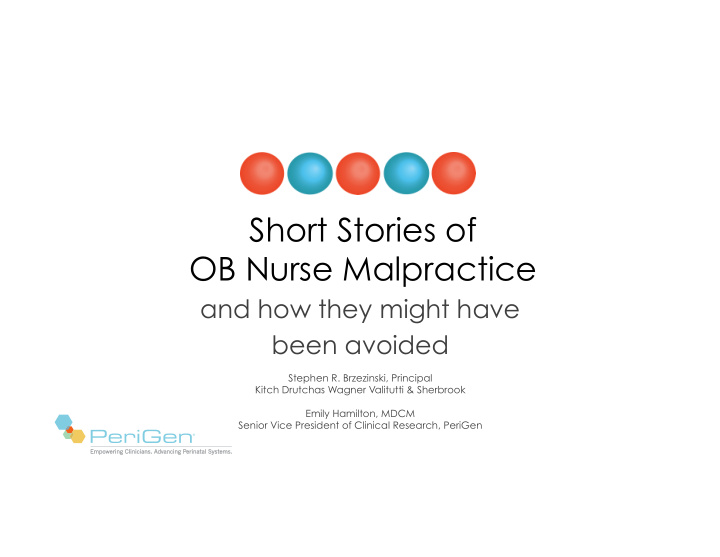



Short Stories of OB Nurse Malpractice and how they might have been avoided Stephen R. Brzezinski, Principal Kitch Drutchas Wagner Valitutti & Sherbrook Emily Hamilton, MDCM Senior Vice President of Clinical Research, PeriGen
Introducing Emily Hamilton, MDCM Stephen R. Brzezinski An experienced obstetrician, Emily leads PeriGen’s clinical Stephen is a top OB defense attorney, leading the research team and currently serves as an Adjunct Professor of birth trauma defense practice at Kitch Drutchas Obstetrics & Gynecology at Wagner Valitutti & Sherbrook in Detroit. He presents McGill University. widely on a variety of issues facing OB/GYN physicians and nurses. Her work focuses on the use of advanced technology to improve obstetric outcomes. In addition to the PeriGen presentation, Stephen will She has authored/co-authored over 50 research articles be presenting “Protocols & Guidelines used in the published in peer-reviewed journals, presents frequently at Interpretation of Uterine Activity and FHR Patterns – obstetric meetings, and holds 32 patents for her work. Help or Hindrance?” on Wednesday morning.
Agenda • Stories from the court room • Questions on tracings • Help at the bedside
Stories from Court
Top Tactics Used to Discredit Your EFM expertise 1. Quiz you on definitions of EFM parameters 2. Quiz you on your own protocols 3. Show non compliance with your own protocols 4. Show discrepancy between your written evaluation and the tracing
Underappreciated Red Flags 1. Uterine tachysystole 2. Duration of tracing abnormality 3. Abnormal tracing on admission
True or False 1. Uterine tachysystole is present when there are A. More than 5 contractions per 10 min, averaged over 30 min. B. More than 15 contractions in 30 min. C. More than 5 contractions in 10 min for any 20 minute interval in the segment. 2. A are B equivalent
30 ¡minutes ¡ ¡ 4 ¡hours ¡ ¡
Accelera4ons ¡ ¡ Baseline ¡ ¡ Decelera4ons ¡ ¡ Contrac4ons ¡ ¡ 9
3.5hrs before birth G1 40+wks labor X 12.5hrs 3600g baby pH ¡6.89 ¡ ¡BD ¡21.4 ¡ ¡Apgar ¡3/5 ¡ 10
2.5 hrs before birth 11
1 hr before birth 12
Last 30 minutes before Birth
This tracing is highly concerning because 1. Decelerations with almost every contraction 2. Decelerations increasing in depth and duration 3. Development of minimal / absent variability 4. Abnormalities persisting and deteriorating for >3hrs 5. All of the above
pH 6.91 BD 20.7 Apgars 3/6 ¡ G1 41+ wks, Spontaneous labor X 4 hrs 3750 g ¡ ¡
Tracing minutes before vaginal delivery
This tracing is highly concerning because 1. Abnormal EFM patterns on admission 2. Late decelerations with almost every contraction 3. High and rising baseline 4. Abnormalities persist for 4hrs 5. All of the above
PeriCALM Checklist pH 6.91 BD 20.7 Apgars 3/6 ¡
EFM Checklists: Be careful what you ask for 1. AVOID alarm fatigue 2. Clinically meaningful and discriminating 3. Timely
Incidence ¡of ¡pts ¡ ctn>15/30 ¡min ¡ ¡ ¡ ¡ Normal ¡ ¡ MA ¡ 12.0% ¡ 10.0% ¡ 8.0% ¡ 6.0% ¡ 4.0% ¡ 2.0% ¡ 0.0% ¡ 270 ¡ 240 ¡ 210 ¡ 180 ¡ 150 ¡ 120 ¡ 90 ¡ 60 ¡ 30 ¡ Minutes ¡before ¡Birth ¡ ¡
Incidence ¡of ¡pts ¡ ctn>15/30 ¡min ¡ ¡ ¡ ¡ Normal ¡ ¡ MA ¡ 12.0% ¡ 10.0% ¡ 8.0% ¡ 6.0% ¡ 4.0% ¡ 2.0% ¡ 0.0% ¡ 270 ¡ 240 ¡ 210 ¡ 180 ¡ 150 ¡ 120 ¡ 90 ¡ 60 ¡ 30 ¡ Minutes ¡before ¡Birth ¡ ¡
Incidence ¡of ¡pt ¡ ¡ ¡ ¡ long ¡ctn>1 ¡(more ¡than ¡120 ¡sec ¡long ¡) ¡ ¡ ¡ Normal ¡ MA ¡ 9.0% ¡ 8.0% ¡ 7.0% ¡ 6.0% ¡ 5.0% ¡ 4.0% ¡ 3.0% ¡ 2.0% ¡ 1.0% ¡ 0.0% ¡ 270 ¡ 240 ¡ 210 ¡ 180 ¡ 150 ¡ 120 ¡ 90 ¡ 60 ¡ 30 ¡
Incidence ¡of ¡pt ¡ ¡ ¡ ¡ long ¡ctn>1 ¡(more ¡than ¡120 ¡sec ¡long ¡) ¡ ¡ ¡ Normal ¡ MA ¡ 9.0% ¡ 8.0% ¡ 7.0% ¡ 6.0% ¡ 5.0% ¡ 4.0% ¡ 3.0% ¡ 2.0% ¡ 1.0% ¡ 0.0% ¡ 270 ¡ 240 ¡ 210 ¡ 180 ¡ 150 ¡ 120 ¡ 90 ¡ 60 ¡ 30 ¡
¡ ¡ ¡ ¡ ¡ ¡
• Definitions Know them when in court • EFM interpretation Assess degree, duration and trends • Create/Test Checklists that are short and efficient • Facilitate accurate and timely documentation
Recommend
More recommend